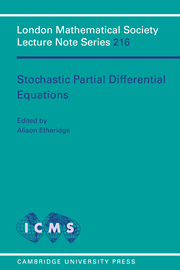Refine search
Actions for selected content:
3023 results in Probability theory and stochastic processes
8 - Brownian Motion
-
- Book:
- Probability
- Published online:
- 05 June 2012
- Print publication:
- 30 August 2010, pp 353-400
-
- Chapter
- Export citation
Preface
-
- Book:
- Probability
- Published online:
- 05 June 2012
- Print publication:
- 30 August 2010, pp ix-x
-
- Chapter
- Export citation
2 - Laws of Large Numbers
-
- Book:
- Probability
- Published online:
- 05 June 2012
- Print publication:
- 30 August 2010, pp 41-93
-
- Chapter
- Export citation
Index
-
- Book:
- Probability
- Published online:
- 05 June 2012
- Print publication:
- 30 August 2010, pp 425-428
-
- Chapter
- Export citation
Frontmatter
-
- Book:
- Probability
- Published online:
- 05 June 2012
- Print publication:
- 30 August 2010, pp i-iv
-
- Chapter
- Export citation
7 - Ergodic Theorems
-
- Book:
- Probability
- Published online:
- 05 June 2012
- Print publication:
- 30 August 2010, pp 328-352
-
- Chapter
- Export citation
3 - Central Limit Theorems
-
- Book:
- Probability
- Published online:
- 05 June 2012
- Print publication:
- 30 August 2010, pp 94-178
-
- Chapter
- Export citation
Appendix A - Measure Theory Details
-
- Book:
- Probability
- Published online:
- 05 June 2012
- Print publication:
- 30 August 2010, pp 401-418
-
- Chapter
- Export citation
6 - Markov Chains
-
- Book:
- Probability
- Published online:
- 05 June 2012
- Print publication:
- 30 August 2010, pp 274-327
-
- Chapter
- Export citation
5 - Martingales
-
- Book:
- Probability
- Published online:
- 05 June 2012
- Print publication:
- 30 August 2010, pp 221-273
-
- Chapter
- Export citation
Contents
-
- Book:
- Probability
- Published online:
- 05 June 2012
- Print publication:
- 30 August 2010, pp v-viii
-
- Chapter
- Export citation
4 - Random Walks
-
- Book:
- Probability
- Published online:
- 05 June 2012
- Print publication:
- 30 August 2010, pp 179-220
-
- Chapter
- Export citation

Stochastic Partial Differential Equations
-
- Published online:
- 04 August 2010
- Print publication:
- 13 July 1995
5 - Branching out
-
-
- Book:
- Probability and Mathematical Genetics
- Published online:
- 07 September 2011
- Print publication:
- 15 July 2010, pp 113-134
-
- Chapter
- Export citation
J - Bogolyubov chains, generating functionals and Fock-space calculus
- from Appendices
-
- Book:
- Nonlinear Markov Processes and Kinetic Equations
- Published online:
- 05 July 2014
- Print publication:
- 15 July 2010, pp 352-355
-
- Chapter
- Export citation
3 - Perfect simulation using dominated coupling from the past with application to area-interaction point processes and wavelet thresholding
-
-
- Book:
- Probability and Mathematical Genetics
- Published online:
- 07 September 2011
- Print publication:
- 15 July 2010, pp 64-90
-
- Chapter
- Export citation
Preface
-
- Book:
- Nonlinear Markov Processes and Kinetic Equations
- Published online:
- 05 July 2014
- Print publication:
- 15 July 2010, pp ix-xiii
-
- Chapter
- Export citation
Contents
-
- Book:
- Nonlinear Markov Processes and Kinetic Equations
- Published online:
- 05 July 2014
- Print publication:
- 15 July 2010, pp v-viii
-
- Chapter
- Export citation
21 - Optimal information feed
-
-
- Book:
- Probability and Mathematical Genetics
- Published online:
- 07 September 2011
- Print publication:
- 15 July 2010, pp 483-490
-
- Chapter
- Export citation
7 - Generators of Lévy–Khintchine type
- from Part II - Nonlinear Markov processes and semigroups
-
- Book:
- Nonlinear Markov Processes and Kinetic Equations
- Published online:
- 05 July 2014
- Print publication:
- 15 July 2010, pp 175-187
-
- Chapter
- Export citation
